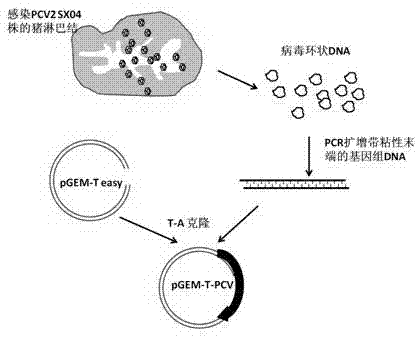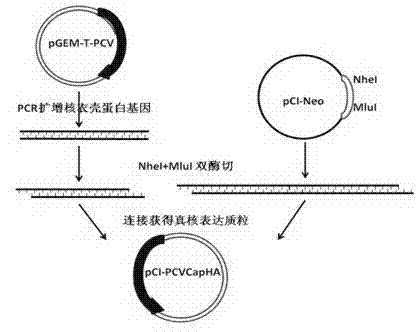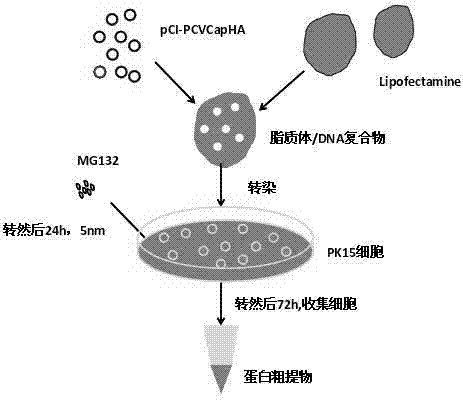Method for overexpression of porcine circovirus type 2 nucleocapsid protein in cells of mammal
A technology for porcine circovirus and nucleocapsid protein, which can be applied in the biological field and can solve problems such as small homology
- Summary
- Abstract
- Description
- Claims
- Application Information
AI Technical Summary
Problems solved by technology
Method used
Image
Examples
Embodiment 1
[0030] The present embodiment has described the whole experimental process of the cloning of porcine circovirus type 2 (PCV 2) SX04 strain whole genome sequence provided by the present invention such as figure 1 shown.
[0031] Weigh an appropriate amount of disease material (inguinal lymph nodes, hilar lymph nodes, and cervical lymph nodes, etc.), add an appropriate volume of tissue lysis buffer for homogenization; divide the tissue homogenate into 1.5ml eppendorf tubes, and centrifuge at 3000g for 10 minutes at room temperature; Take the supernatant and add proteinase K to a final concentration of 100μg / ml, lyse at 55°C for 3h; add an equal volume of phenol / chloroform, mix upside down, centrifuge at 12000g for 10min at 4°C; put the supernatant into a new 1.5ml eppendorf tube Medium; put the supernatant into a new 1.5ml eppendorf tube, add 2 times the volume of ice-cold absolute ethanol (containing 1 / 10 volume of 3M NaAc), mix up and down, -20°C, 40min, precipitate DNA; 4 Ce...
Embodiment 2
[0038] This example describes the construction of the eukaryotic expression plasmid containing porcine circovirus type 2 (PCV2) nucleocapsid protein gene provided by the present invention. Such as figure 2 shown
[0039] According to the genome sequence of the PCV2SX04 strain, specific primers (Table 2) were designed, and an HA tag was introduced at the C-terminus of the protein for protein detection.
[0040] Table 2 Primer sequences for porcine circovirus nucleocapsid protein gene amplification
[0041]
[0042] The PCR reaction was carried out according to the operation guide of the Roche Expand High Fidelity PCR System, using the extracted viral DNA as a template, and the PCR reaction parameters were pre-denaturation at 94°C for 3min, denaturation at 94°C for 15sec, annealing at 58°C for 45sec, and extension at 68°C for 2min; cycle 30 times, 72°C extension for 10min. After the reaction is completed, 1-21% agarose gel electrophoresis is used for detection, and a PCV2...
Embodiment 3
[0045] This example describes the transfection of pCI-PCVCapHA plasmid into porcine kidney cell PK15 provided by the present invention, and adding MG132 to the cell culture medium 24 hours after transfection. Such as image 3 shown.
[0046] According to the kit instructions, the pCI-PCVCapHA transfection-grade ultrapure plasmid was extracted with the QIAGEN Plasmid Plus Midi Kit. Under the mediation of liposome Lipofectamine 2000, pCI-PCVCapHA was used to transfect 80% confluent PK15 cells (No. 1 and No. 2 wells), and a control group (No. 3 well) which only transfected liposomes was set up. PK15 cells used for transfection and related experiments were cultured on 6-well plates. After 24 hours of transfection, replace the cell culture medium, and add MG132 (proteasome inhibitor, ), the concentration is 5nm; DMSO is added to the culture solution of No. 2 well, the concentration is 1ul / ml. Well 3 was a negative control. Continue culturing for 48 hours.
PUM
| Property | Measurement | Unit |
|---|---|---|
| diameter | aaaaa | aaaaa |
Abstract
Description
Claims
Application Information
 Login to View More
Login to View More - R&D Engineer
- R&D Manager
- IP Professional
- Industry Leading Data Capabilities
- Powerful AI technology
- Patent DNA Extraction
Browse by: Latest US Patents, China's latest patents, Technical Efficacy Thesaurus, Application Domain, Technology Topic, Popular Technical Reports.
© 2024 PatSnap. All rights reserved.Legal|Privacy policy|Modern Slavery Act Transparency Statement|Sitemap|About US| Contact US: help@patsnap.com










